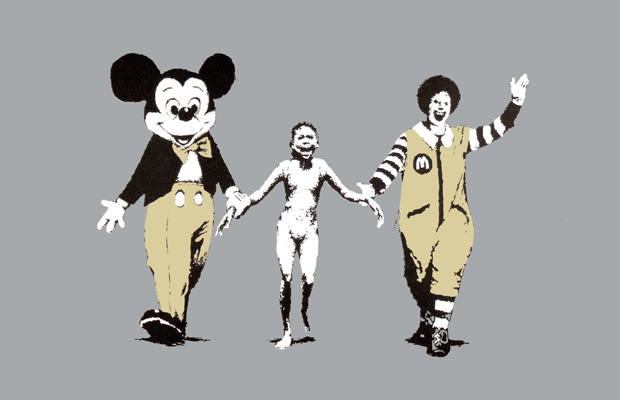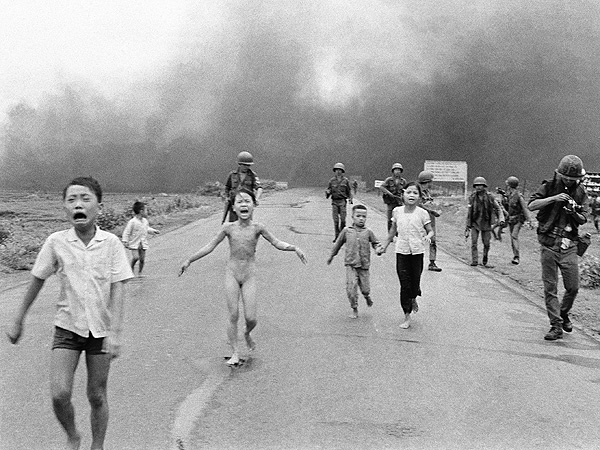Glocalisation: Globalisation & Localisation. The adaptation of items around the world, typically branded items. For example: Walkers crisps & Lays crisps, the vast variety of KitKat flavours in Japan, McDonald sizes in Britain vs. America (Regular size/Super size).
Visual examples of Globalisation/Glocalisation:
Banksy is an anonymous graffiti artist whom paints the streets with all forms of satirical art. He is known, ironically, for his lack of identity and his ability to convey political messages through his artwork, and thus creates a recurring theme of consumerism within his work.
One particular piece which relates to globalisation/consumerism is the canvas screen-print of 'Consumer Jesus'. The piece depicts the well known religious figure, Jesus, in the crucifixion pose carrying a selection of shopping bags in his hands. This piece of work is said to relate to the consumerism which typically takes place during the festivities of Christmas time (hence the use of a candy cane in one of the bags) and includes the well known brand of Disney through the incorporation of a Mickey Mouse doll. This particular detail, although very minute in scale with the rest of the piece, reflects the international influence that Disney carries all over the globe as the doll is a recognized figure, and thus globalisation becomes a highlighted theme within the image.
Another of Banksy's works which reflects the effects of globalisation is his 'Napalm' piece. The subject of this image is nine-year old Kim Phuc, originally photographed in 1972 by Nick Ut running from her home after a Napalm blast. In using such a distressing base figure for his piece and replacing the disastrous background with the figures of Mickey Mouse and Ronald McDonald, Banksy makes clear reference to the underlying negative effects of globalisation across the world, showing that while these corporate brands develop and grow on an international scale, the consumerism which accompanies it does nothing to improve the quality of life for human beings such as Kim Phuc, and thus the contrast between each figure in this piece (specifically the varying expressions) creates and intense and shocking critique aimed towards big brands and their consumers.
The Chapman Brothers are a pair of English artists who often create deliberately shocking subject matter and thus the likes of globalisation has been included in many of their projects. Their 'Wheel of Fortune' creation, which is composed of mixed medias such as glass fiber and plastic, depicts a hellish landscape scatter with dead bodies, some naked and others garbed in Nazi uniform, Ronald McDonald's and a few religious symbols such as the cross - just for good measure. This grotesque scene most certainly captures their "deliberately shocking" way with producing artwork and the use of the McDonalds' brand figure, Ronald McDonald, reinforces the idea of the negative effects behind globalisation. In creating such a frightening scene, the Chapman Brothers also force viewers to look at these particular brands in a negative light, connotating them with the unexplainable and formidable displays and thus causing and uncomfortable confusion as to what truly lies behind these big name brands.
The Designers Republic are a graphic design studio based in Sheffield, England, and are known for their anti-establishment aesthetics with a clutch on impetuous consumerism.
One of their pieces, "Work, buy, consume, die" conveys a bold and rather blunt message. The design is simple and straightforward, contains a branded logo, and basically tells you like it is, making it very direct towards the viewer and highlighting the harsh reality of our lives as consumers within globalisation. In being so up front with their message, tDR create a sense of unease among consumers as the piece suggests we have been ignorant to the effects of globalisation/consumerism for so long that the only way to get the message across is to be as direct as possible.
'The Little Book of Shocking Global Facts' is a "powerful visual manifesto highlighting the inequalities of rampant globalisation...". It was both written and designed by a British graphic designer named Jonathan Barnbrook, The book itself is divided into several different sections, including: human rights, trade, environment, war, arms trade, health population and illicit drugs and it harnesses the use of graphics, typography, photographs and statements - all of which reiterate the many social and ethical issues within our world today - in order to convey the shameful realities we are so often ignorant to.
Sources used:
- http://uk.complex.com/style/2013/11/banksy-greatest-works/
- http://www.people.com/article/nick-ut-napalm-girl-photo-kim-phuc
- http://jakeanddinoschapman.com/works/wheel-of-misfortune/11003/
- http://www.barnbrook.net/fiell.html
- http://www.designboom.com/design/the-little-book-of-shocking-global-facts/
- http://www.creativereview.co.uk/cr-blog/2010/july/barnbrooks-little-book-of-shocking-global-facts









No comments:
Post a Comment